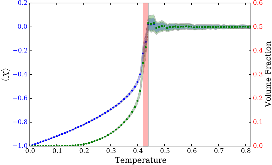Information-entropic signature of the critical point
Abstract
Here, we investigate the critical behavior of continuous (second-order) phase transitions in the context of (2 + 1)-dimensional Ginzburg–Landau models with a double-well effective potential. In particular, we show that the recently-proposed configurational entropy (CE)—a measure of the spatial complexity of the order parameter in momentum space based on its Fourier-mode decomposition—can be used to identify the critical point. We compute the CE for different temperatures and show that large spatial fluctuations near the critical point (Tc)—characterized by a divergent correlation length—lead to a sharp decrease in the associated configurational entropy. We further show that the CE density goes from a scale-free to an approximate scaling behavior |k|–5/3 as the critical point is approached. As a result, we reproduce the behavior of the CE at criticality with a percolating many-bubble model.
- Authors:
- Publication Date:
- Research Org.:
- Dartmouth College, Hanover, NH (United States)
- Sponsoring Org.:
- USDOE
- OSTI Identifier:
- 1209772
- Alternate Identifier(s):
- OSTI ID: 1457029
- Grant/Contract Number:
- SC0010386; 48038
- Resource Type:
- Published Article
- Journal Name:
- Physics Letters B
- Additional Journal Information:
- Journal Name: Physics Letters B Journal Volume: 747 Journal Issue: C; Journal ID: ISSN 0370-2693
- Publisher:
- Elsevier
- Country of Publication:
- Netherlands
- Language:
- English
- Subject:
- 71 CLASSICAL AND QUANTUM MECHANICS, GENERAL PHYSICS; 97 MATHEMATICS AND COMPUTING
Citation Formats
Gleiser, Marcelo, and Sowinski, Damian. Information-entropic signature of the critical point. Netherlands: N. p., 2015.
Web. doi:10.1016/j.physletb.2015.05.058.
Gleiser, Marcelo, & Sowinski, Damian. Information-entropic signature of the critical point. Netherlands. https://doi.org/10.1016/j.physletb.2015.05.058
Gleiser, Marcelo, and Sowinski, Damian. Wed .
"Information-entropic signature of the critical point". Netherlands. https://doi.org/10.1016/j.physletb.2015.05.058.
@article{osti_1209772,
title = {Information-entropic signature of the critical point},
author = {Gleiser, Marcelo and Sowinski, Damian},
abstractNote = {Here, we investigate the critical behavior of continuous (second-order) phase transitions in the context of (2 + 1)-dimensional Ginzburg–Landau models with a double-well effective potential. In particular, we show that the recently-proposed configurational entropy (CE)—a measure of the spatial complexity of the order parameter in momentum space based on its Fourier-mode decomposition—can be used to identify the critical point. We compute the CE for different temperatures and show that large spatial fluctuations near the critical point (Tc)—characterized by a divergent correlation length—lead to a sharp decrease in the associated configurational entropy. We further show that the CE density goes from a scale-free to an approximate scaling behavior |k|–5/3 as the critical point is approached. As a result, we reproduce the behavior of the CE at criticality with a percolating many-bubble model.},
doi = {10.1016/j.physletb.2015.05.058},
journal = {Physics Letters B},
number = C,
volume = 747,
place = {Netherlands},
year = {Wed Jul 01 00:00:00 EDT 2015},
month = {Wed Jul 01 00:00:00 EDT 2015}
}
https://doi.org/10.1016/j.physletb.2015.05.058
Web of Science
Figures / Tables:
 Fig. 1: (Color online.) The order parameter 〈X〉 [top (blue) line] and the volume fraction (pV ) occupied by the X > 0 phase [bottom (green) line] vs. temperature. The shaded regions correspond to 1σ deviations from the mean. Within the accuracy of our simulation, the critical temperature is θcmore »
Fig. 1: (Color online.) The order parameter 〈X〉 [top (blue) line] and the volume fraction (pV ) occupied by the X > 0 phase [bottom (green) line] vs. temperature. The shaded regions correspond to 1σ deviations from the mean. Within the accuracy of our simulation, the critical temperature is θcmore »
Works referenced in this record:
A Mathematical Theory of Communication
journal, July 1948
- Shannon, C. E.
- Bell System Technical Journal, Vol. 27, Issue 3
Information-entropic stability bound for compact objects: Application to Q-balls and the Chandrasekhar limit of polytropes
journal, November 2013
- Gleiser, Marcelo; Sowinski, Damian
- Physics Letters B, Vol. 727, Issue 1-3
Matching numerical simulations to continuum field theories: A lattice renormalization study
journal, January 1997
- Borrill, Julian; Gleiser, Marcelo
- Nuclear Physics B, Vol. 483, Issue 1-2
On thermalization in classical scalar field theory
journal, October 2000
- Aarts, Gert; Bonini, Gian Franco; Wetterich, Christof
- Nuclear Physics B, Vol. 587, Issue 1-3
Entropic measure for localized energy configurations: Kinks, bounces, and bubbles
journal, July 2012
- Gleiser, Marcelo; Stamatopoulos, Nikitas
- Physics Letters B, Vol. 713, Issue 3
A Mathematical Theory of Communication
journal, October 1948
- Shannon, C. E.
- Bell System Technical Journal, Vol. 27, Issue 4
Configurational entropy elucidates the role of salt-bridge networks in protein thermostability
journal, July 2007
- Missimer, John H.; Steinmetz, Michel O.; Baron, Riccardo
- Protein Science, Vol. 16, Issue 7
Scale-space for discrete signals
journal, March 1990
- Lindeberg, T.
- IEEE Transactions on Pattern Analysis and Machine Intelligence, Vol. 12, Issue 3
Nonperturbative dynamics of reheating after inflation: A review
journal, December 2014
- Amin, Mustafa A.; Hertzberg, Mark P.; Kaiser, David I.
- International Journal of Modern Physics D, Vol. 24, Issue 01
Exact and truncated dynamics in nonequilibrium field theory
journal, December 2000
- Aarts, Gert; Bonini, Gian Franco; Wetterich, Christof
- Physical Review D, Vol. 63, Issue 2
Transition to order after hilltop inflation
journal, March 2014
- Gleiser, Marcelo; Graham, Noah
- Physical Review D, Vol. 89, Issue 8
Information content of spontaneous symmetry breaking
journal, August 2012
- Gleiser, Marcelo; Stamatopoulos, Nikitas
- Physical Review D, Vol. 86, Issue 4
Figures / Tables found in this record:

 Search WorldCat to find libraries that may hold this journal
Search WorldCat to find libraries that may hold this journal